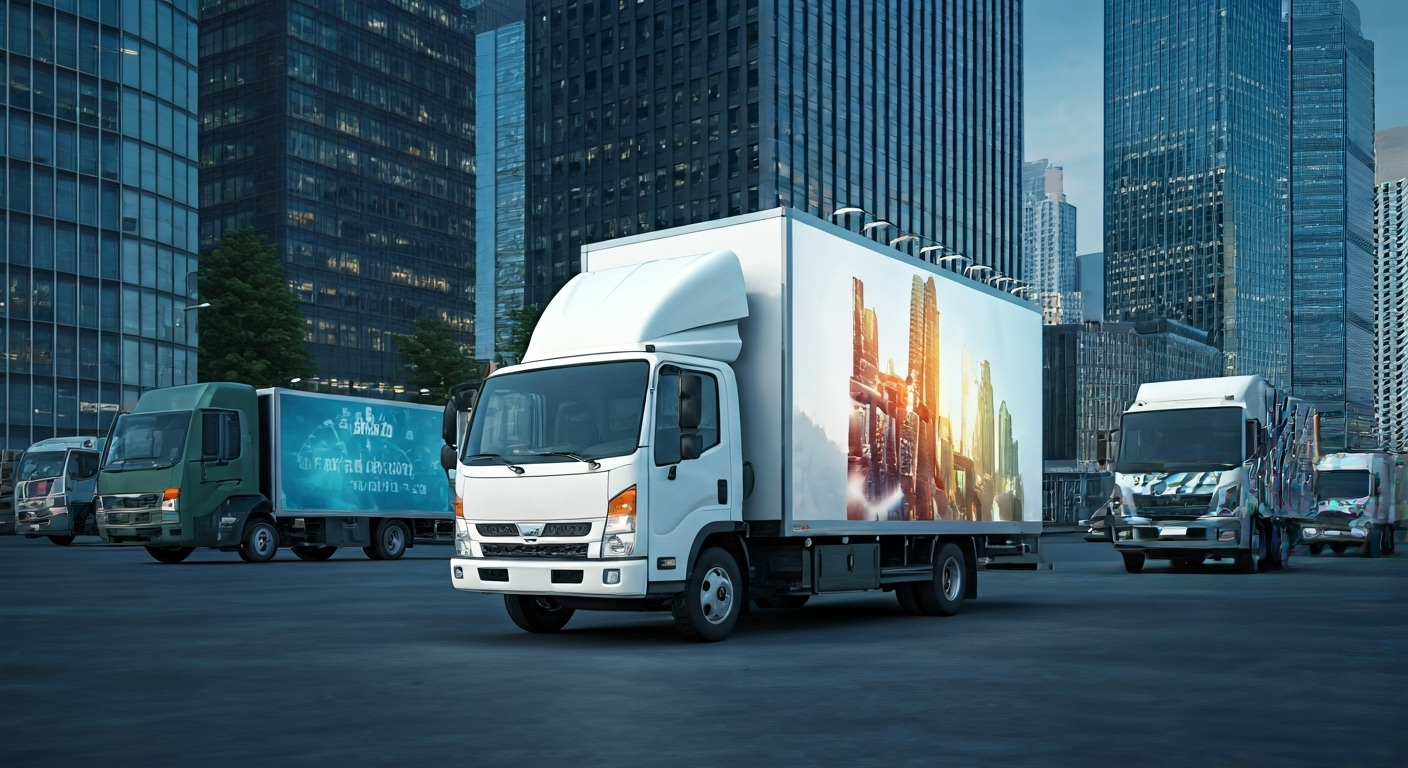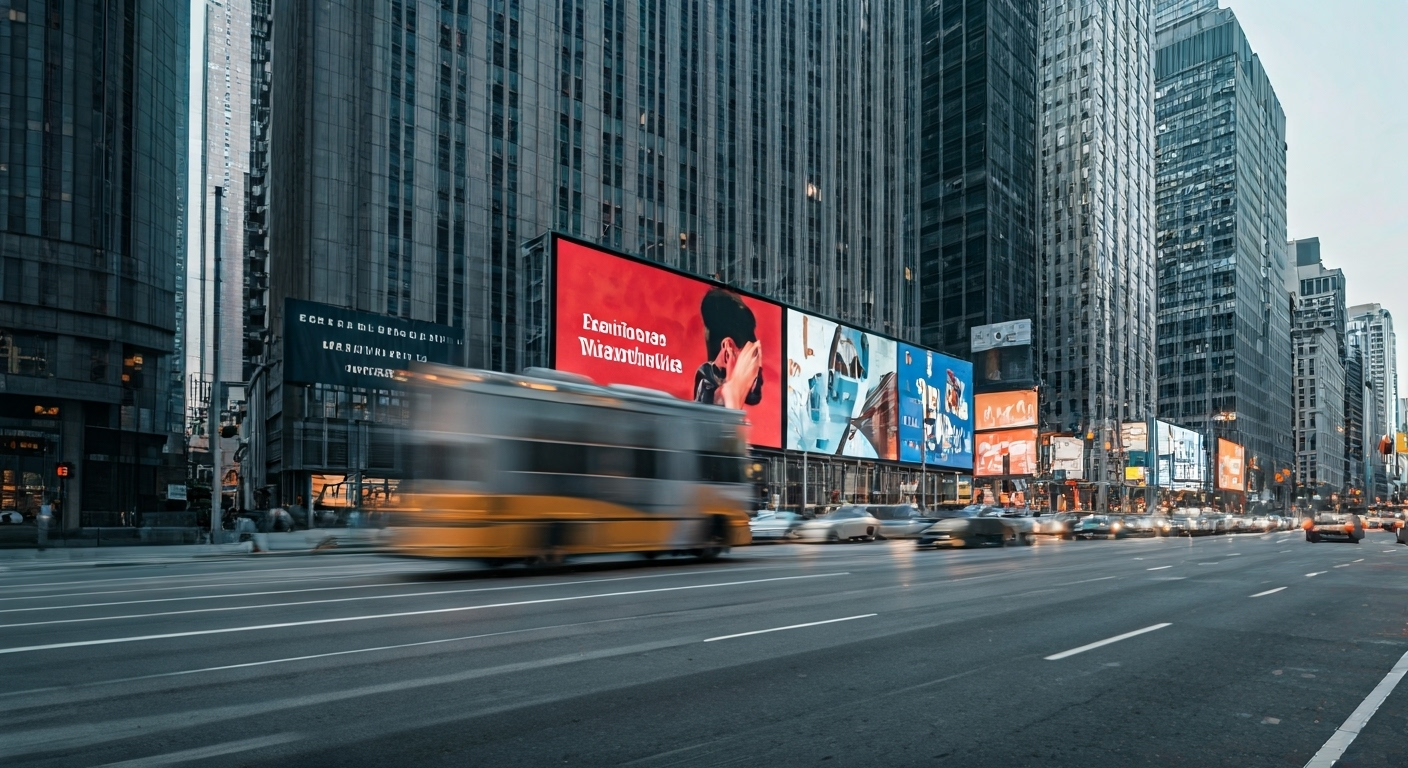Looking for an eye-catching way to elevate your advertising campaign? Mobile LED billboard advertising is transforming outdoor advertising, taking your message mobile.
Unlike traditional static advertising spots, these dynamic ads are transported by trucks or specially equipped vehicles, capturing attention wherever they go.
Mobile billboards enable brands to reach their target audiences in crowded city centers, local neighborhoods, and even at large-scale events. This ultimate guide will walk you through the basic strategies, types, and costs so you can confidently launch your next mobile advertising campaign.
What is a mobile LED billboard?
A mobile LED billboard is a mobile advertisement mounted on a vehicle like a truck or trailer. These eye-catching displays travel through busy streets, neighborhoods, or event venues, making them a popular mobile advertising method. Their key advantage is the ability to physically deliver your brand message to places frequented by your target audience.
For advertising campaigns, mobile LED billboards can be operated along predetermined routes or parked in strategic locations, ensuring your brand message reaches pedestrians, commuters, and event attendees. Advertising vehicles are particularly effective in high-traffic areas where traditional advertising space may be limited or saturated.
Mobile billboards stand out for their visibility and flexibility. You can customize the format (static image or digital content) to suit your campaign goals and budget. By moving from location to location, these billboards can achieve greater reach and leave a memorable impression on viewers.
How Mobile Billboards Operate in Advertising Campaigns
Mobile billboard advertising campaigns are executed by mounting advertisements on billboard trucks, which then travel through carefully selected local routes.
These trucks are driven during peak hours to maximize visibility, often targeting areas with high pedestrian or vehicular traffic. This ensures your advertising campaign consistently reaches your target audience.
The routes and schedules are planned based on your campaign objectives. For instance, if you’re aiming to promote an event, your mobile billboard truck can circulate around the venue during key hours.
If brand awareness is the goal, the truck may cover several neighborhoods or business districts, exposing your message to diverse demographics.
Unlike static billboards, mobile billboard advertising provides flexibility to adapt routes and schedules on short notice. This allows you to respond to changing audience patterns, local events, or even weather conditions, maximizing your campaign’s effectiveness in real time.
Types of Mobile Billboards in the United States

Mobile LED billboards come in several varieties, each offering distinct advantages for billboard advertising. In the United States, the most common types include traditional truck-based displays, innovative digital billboard screens, and truck side advertising. While truck-based mobile billboard trucks are well-known for their classic approach, digital and LED billboard options usher in modern, dynamic content capabilities.
Understanding these types helps you tailor your advertising campaign based on your brand’s message, location, and budget. Let’s look at these options in detail, starting with traditional truck-based billboards.
Traditional Truck-Based Billboards
Traditional truck-based billboards represent one of the earliest forms of mobile advertising. These billboard trucks feature large, static posters or banners attached to the sides of a vehicle, typically a box truck or trailer. These classic displays are easily recognizable and deliver a strong, consistent message as they move through outdoor advertising spaces.
A key benefit of traditional billboards is their straightforward design, which keeps production and operating costs relatively low.
Because the advertisement remains unchanged throughout the campaign, it’s ideal for long-term branding efforts or promotions that don’t require frequent updates. Advertisers choose this option to maximize exposure along established routes in busy commercial or urban districts.
Compared to digital or LED alternatives, traditional truck-based billboards are less interactive but remain highly effective for straightforward brand messaging, especially for businesses wanting steady visibility in specific locations.
Digital and LED Mobile Billboards
Digital and LED mobile billboards take mobile billboard advertising to the next level. Mounted on trucks or specialized vehicles, these screens display dynamic, high-resolution content that can be updated in real time.
This allows advertisers to run multiple messages, adjust creative based on the time of day, or target specific audiences more effectively during their advertising campaign.
The flexibility to change content on the fly is a major advantage, especially for brands with time-sensitive offers or multiple products.
For instance, a digital billboard can flash a breakfast promotion in the morning and switch to dinner specials later in the day. This custom targeting often results in higher engagement and better recall.
While digital and LED options typically have higher upfront costs than static truck side advertising, the ability to deliver impactful, moving visuals makes them a preferred choice for brands seeking to stand out in crowded urban environments.
Benefits of Mobile Billboard Advertising Over Stationary Methods

Mobile billboard advertising offers several advantages when compared to static billboards.
One key benefit is high visibility—mobile ads reach people in congested areas, on the move, and at various times of day, making them an effective way to enhance brand recognition. Unlike stationary outdoor advertising, mobile billboard trucks can cover multiple routes and events, ensuring more eyes on your message.
These unique strengths translate to increased impact and flexibility, giving your advertising campaign a competitive edge. Next, let’s discuss in detail how these campaigns reach wider audiences and offer advanced targeting.
High Visibility and Wider Reach
Mobile billboard advertising stands out because of its exceptional visibility and ability to reach a wider audience. Whether traveling through congested city streets or circling event venues, billboard trucks are hard to miss.
This high visibility results in more impressions, which can significantly boost brand recognition, especially in places where traditional outdoor advertising options are limited.
“Mobile billboards enable prompt dissemination of advertisements to a vast audience, thanks to their swift movements,” as digital marketing expert Michael Smith explains.
By moving through different locations at peak times, mobile billboards expose your brand’s message to commuters, pedestrians, and event-goers who may otherwise miss stationary ads.
The benefit of this wider reach is clear: your advertising campaign can adapt to changing traffic flows, hit multiple neighborhoods in a single day, and capture audiences on the go—all with a single billboard truck.
Enhanced Targeting and Flexibility
A major strength of mobile billboard advertising is its enhanced targeting and flexibility. Unlike static billboards locked into one spot, mobile billboards allow you to select different locations and times to reach your desired audience.
This means you can focus your advertising campaign on business districts during the morning rush, stadiums during sporting events, or shopping centers on weekends.
The flexibility of mobile billboard trucks lets you adjust routes and schedules in real time, responding to local events or shifting traffic patterns.
For example, you might reroute your billboard truck to cover unforeseen road closures or capitalize on spontaneous community gatherings, making sure your brand’s message is always delivered at optimal moments.
This ability to fine-tune your campaign ensures higher relevance, stronger brand recognition, and better use of your advertising budget compared to stationary outdoor advertising.
Key Factors Affecting Mobile Billboard Advertising Costs
When considering the cost of mobile billboard advertising, several factors significantly impact your overall budget.
Expenses vary depending on your campaign’s duration, the complexity of your billboard design, and the type of mobile billboard truck used. Regional considerations, such as choosing routes in major cities versus smaller towns, also influence pricing.
Understanding these cost drivers helps you plan an effective advertising campaign without unplanned expenses. Let’s examine how local routes and campaign duration affect the cost of billboard advertising.
Regional and Route Considerations
Where and when your mobile billboard operates plays a crucial role in determining costs. Advertising in high-traffic urban centers or during peak hours generally comes at a premium, while campaigns in smaller towns or during off-peak times may be more affordable.
The choice of local routes, time of day, and even days of the week all contribute to the final price.
Mobile billboard trucks can be routed to match your target audience’s behaviors, but high-demand locations like downtown areas or event venues will often require higher investment. Traffic congestion, parking regulations, and city-specific restrictions can add further complexity and cost.
Below is a table summarizing key regional considerations:
| Regional Factor | Impact on Cost |
|---|---|
| Major city routes | Higher due to traffic and visibility |
| Suburban/small town | Lower cost, fewer impressions |
| Event-centric routes | Moderate to high, short-term high visibility |
| Time of day (rush hour) | Higher during peak traffic periods |
| Route length | Longer routes may increase operational expenses |
Choosing routes and times wisely keeps campaign costs in check and maximizes exposure.
Duration, Design Complexity, and Billboard Type
The length of your campaign, the intricacy of your billboard design, and the type of mobile billboard selected are all major cost factors.
Longer advertising campaigns typically offer better rates per day, but require a higher initial budget. A one-day event may cost less up front, but ongoing visibility brings more value over time.
Design complexity also drives pricing. A simple, static mobile billboard is more affordable to produce and install, while digital or 3D designs add to the total bill due to technology and customization needs. For example, designing for both sides of a truck generally ranges from $400 to $700.
Billboard type matters too. Static mobile billboards typically cost between $500 and $3,000 per day, while digital LED billboard trucks range from $1,000 to $5,000 daily.
Selecting the right combination of duration, design, and format helps balance your advertising campaign goals with your budget.
Conclusion
In conclusion, mobile billboard advertising presents a dynamic and effective strategy for brands seeking to capture attention and engage with their target audience.
With its ability to offer high visibility, wider reach, and enhanced targeting, mobile billboards stand out as a powerful tool in the advertising arsenal. Understanding the different types of mobile billboards and their operational mechanics is crucial for maximizing your campaign’s effectiveness.
As you venture into this innovative advertising space, consider the factors impacting costs and the regulations that may apply in various regions.
Embrace the potential of mobile billboards and watch your brand’s message travel far and wide. If you’re ready to elevate your advertising game, don’t hesitate to reach out for expert strategies that can make your campaign a resounding success.
Frequently Asked Questions
What regulations should I know about mobile billboard advertising in different U.S. cities?
Mobile billboard advertising regulations differ by city and state. Some locations require special permits, restrict certain types of outdoor advertising, or limit routes and operating hours. Always research local ordinances before planning your advertising campaign to ensure compliance and avoid fines or disruptions.
How can I measure the effectiveness or ROI of my mobile billboard campaign?
To gauge effectiveness and ROI, track metrics such as impressions, reach, and frequency. Many providers offer GPS tracking and campaign reporting. Additionally, monitor brand recognition through website visits, social media engagement, and increased call volume resulting from your advertising campaign.
What are the biggest challenges or drawbacks of mobile billboard advertising?
Mobile billboard advertising faces challenges like limited exposure time, route restrictions, and variable weather conditions. Measurement of audience impact can be less precise than digital media. Planning your campaign around these drawbacks and working with reputable providers helps overcome most obstacles for outdoor advertising.


